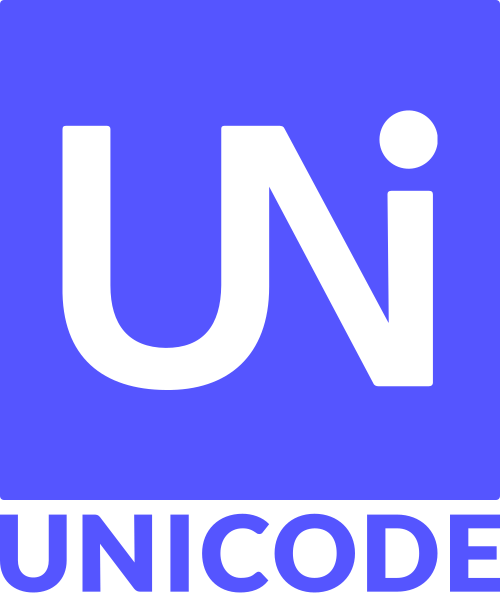Facts for Kids
Unicode is a text encoding standard that helps computers understand and share text in all of the world's languages by using special codes for each character.
Overview
Future Of Unicode
Unicode Structure
History Of Unicode
Character Encoding Forms
Unicode In Web Development
Challenges In Unicode Adoption
Unicode In Different Languages
Unicode Vs Other Character Sets
Internationalization And Localization
Implementation In Programming Languages

Inside this Article
Organization
Technology
Mandarin
Japanese
English
Product
People
Matter
Apple
Ascii
Face
Did you know?
📚 Unicode is like a library that holds letters, numbers, and symbols from all over the world.
🌎 It supports over 143,000 characters from more than 150 different writing systems!
💻 Unicode helps people send messages in different languages without confusion.
🌟 The Unicode Consortium introduced Unicode in 1991 with the aim of helping all languages work on computers.
😲 Before Unicode, there were more than 7,000 ways to write text, making it hard to share information.
📊 Each character in Unicode has a special code called a 'code point' to identify it.
😊 Unicode can represent characters like emojis, allowing fun expressions in messages!
📜 The most popular Unicode Character Encoding Forms (CEFs) are UTF-8, UTF-16, and UTF-32.
🌐 In countries like India and China, Unicode helps write languages like Hindi and Mandarin easily.
🎉 Unicode keeps growing with new characters and emojis, making it part of our everyday digital communication.
Introduction
This means you can send a message in Japanese and it will be read correctly in another country. Thanks to Unicode, people around the world can communicate easily using computers and smartphones! 💻📱
Future Of Unicode
️ The Unicode Consortium continues to add new characters, emojis, and scripts! 🎈
In recent years, they’ve added symbols for different cultures, including new flags and even more emojis! 🏳
️🌈📱 As people create new languages and symbols, Unicode keeps evolving to support them. Imagine if one day we have emoji for every type of food! 🍕🍣🍦 The goal is to help everyone, no matter who they are or where they come from, to express themselves using computers!
Unicode Structure
Each character is given a unique number called a "code point." For example, the letter "A" has the code point U+0041. Characters are grouped into blocks, which are like sections in a big book. 📚
There are blocks for Latin letters, Arabic letters, emojis 😊, and even musical symbols! 🎶
This organization helps computers find and display characters correctly, so when you type on a keyboard, the text appears just as you want it!
History Of Unicode
The goal was to make sure every language could be used on computers! Before Unicode, computers had trouble understanding different languages, which made it hard to share text. Can you believe there were over 7,000 different ways to write text? 😲
With Unicode, all these languages could fit in the same system! Today, Unicode keeps growing, adding more characters and symbols, so everyone can be included! 🌍❤️
Character Encoding Forms
UTF-8 is like a magic code that saves space! It can use just one byte for many English characters and more for others like emoji and Asian scripts. UTF-16 works with two bytes, helping with many characters but using more space. Finally, UTF-32 uses four bytes for every character, which is simple but uses a lot of memory! 💾
Choosing the right one helps computers handle text efficiently!
Unicode In Web Development
When you see text online, Unicode helps to showcase many languages and emojis correctly. Web developers use HTML codes like &x1F600; to show a smiling face emoji. 😃
People visiting websites, from different parts of the world, can see the same content without confusion! This makes the internet a more friendly and connected place. 🌍📲 Without Unicode, many websites would struggle to show the right characters, making it harder for people worldwide to enjoy the web!
Challenges In Unicode Adoption
☠️ In the beginning, many software programs didn't support it. This made it hard to see characters correctly. Some older systems used a different way to write text, which caused confusion. 🤯
Also, some people didn't know about Unicode and kept using older systems! But with technology growing, more programs now support Unicode. 💾
It’s a work in progress, but little by little, more people are joining the Unicode party! 🎉
Unicode In Different Languages
In Africa, many languages like Swahili are represented too! With Unicode, a person in Brazil can send a message to someone in Japan without worrying about their messages getting scrambled. That’s super cool! 🌏💌
Unicode Vs Other Character Sets
ASCII could only handle English letters and some symbols. That’s why it was tough to use other languages! Unicode is a superhero because it covers languages from all around the world, making it better for sharing. 🌈
Other character sets, like ISO 8859, handle specific languages but forget about others. With Unicode, you don’t have to worry! 🌍✨ It brings everyone together and helps everyone communicate!
Internationalization And Localization
Unicode plays a big role in both! It allows developers to build their products in one code but change the language and symbols based on users. Think about a game that is popular in the USA but wants to reach Japan; Unicode helps that game translate easily! 🎮
This way, everyone can play, no matter where they are from!
Implementation In Programming Languages
💻 they can use characters from different languages without any trouble. For example, when you see "こんにちは" (Hello in Japanese), it’s being handled by Unicode in the background! 🌈
This makes it easier for apps and websites to be used by everyone, no matter where they are from. When you create a game or website, you want users from around the world to enjoy it, and Unicode makes that happen! 🎮🌍

